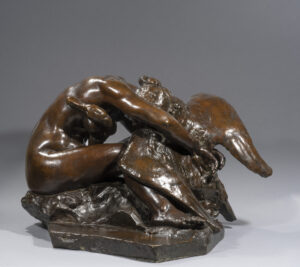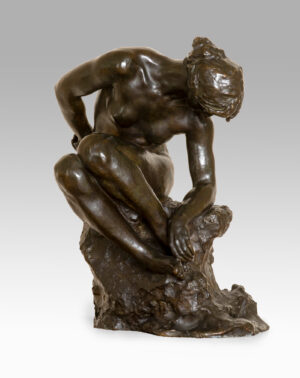Jules DESBOIS
(1851-1935)
After three years of study at the École des Beaux-Arts of Angers, Desbois was selected to attend the École des Beaux-Arts in Paris. A student of Cavelier, he exhibited for the first time at the Salon in 1875 (Orpheus). Giving up sculpture for a while, he was tempted by a three-year’s stay in America. On his return to France, it was through his contact with Rodin that Desbois really grew a passion for sculpture and finally developed his talent by shifting towards a sensual art, free of all academic rigidity. Desbois received his first major commission in 1855 from Baron Alphonse de Rothschild (Acis changed into a river). But it was at the 1886 Salon that he displayed Satyr and Nymph (marble, Parçay-les-Pins, Maine-et-Loire, musée Jules Desbois), a turning point in his career in which he fully expressed his creative talent. At the age of thirty-five, Desbois was proving to himself that he was a sculptor. He nevertheless went on collaborating with Rodin on monumental projects, in Paris and in the provinces. Then, from April 1886 to August 1887, he was also employed at the Manufacture de Sèvres to work on various projects. In 1890, he was one of the first members of the Société Nationale des Beaux-Arts; on this occasion, he exhibited a spectacular group Death and Woodcutter (nowadays destroyed), which the entire press recognized as the Salon’s “highlight”; he there tackled the theme of illness and death in a masterly way, without any artifice. This sense of compassion, of human fraternity, accompanied him through his whole life as an artist, as shown by his Misery (1894) (plaster version). But there is also another Desbois, passionate about the female body, which he studied in always very elaborate curves, with a composition most often based on a very dynamic helical line. A poet of the flesh, Jules Desbois was admired by his contemporaries for the mastery, subtlety and fluidity of his models. Jules Desbois also took part in the revival, in his time, of decorative arts and presented his first pieces as soon as 1892 – bronze, silver, ceramics and more particularly pewter – where various repertoires mingle, Japonism, naturalism and mythological subjects. Auguste Rodin, who fully appreciated him, declared in 1911: “Go and see Desbois! He practises sculpture with a fervour that borders on religion”.


